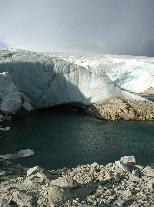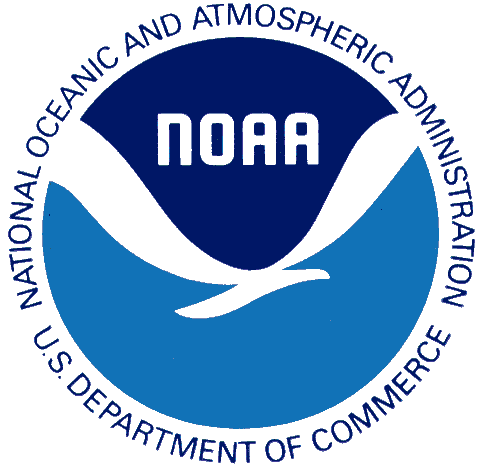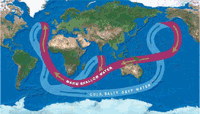 |
|
LAMONT-DOHERTY EARTH OBSERVATORY THE EARTH INSTITUTE AT COLUMBIA UNIVERSITY |
||
| Abrupt Climate Change | ||
| LDEO | ||
| Home | ||
| Divisions | ||
| LDEO Search | ||
| Abrupt CC | ||
| Home | ||
| Q&A | ||
| Contacts | ||
| Research | ||
| Links |
We all know that
climate is either going to change, or
is already doing so, as a result of human activities
changing the atmosphere's composition and
its land surface. If climate change occurs gradually then
it is hoped that societies will have time to adjust to
the undoubtedly large consequences, such as an increase in occurrences of summertime
droughts in North America or the submergence of large areas of
Bangladesh under rising sea levels. If, on the other hand, the changes occur abruptly
there may be no time to plan, causing severe stress on
the resource systems - agriculture, water, energy, for
example - that support complex social systems and even risking
political and economic chaos.
We know from studies of the climate of the last thousands and
tens of thousands of years that climate has changed abruptly
in the past. We also know that many different aspects of
the climate can change abruptly. Probably the best-known
changes are the sudden cessations of the ocean currents that
bring warm subtropical water up into the North Atlantic Ocean
and which, in present-day conditions, allow the northwest coast of Norway to
be ice free in winter. These shifts in ocean circulation have
occurred repeatedly in the past and there is at least some
fear that greenhouse warming could cause it to happen again.
Abrupt changes in precipitation around the world have also occurred.
There is abundant evidence of a catastrophic drying of Mesopotamia
(modern day Iraq) around 4,200 years ago, coincident with the collapse of the
culturally advanced Akkadian empire. Collapses of advanced
Indian civilizations in North, Central and South America within
the last two thousand years also coincided with well-documented
droughts. These must have been caused by abrupt shifts in the
circulations of the atmosphere and ocean but we do not know how
or why these occurred. However, wherever we look, it appears that the
climate system has different ways of "operating" and that it
can rapidly jump between them.
Climate researchers are beginning to better understand the nature
and causes of abrupt climate change. These advances are being used,
amidst a sense of urgency, to assess the future risks of climate
change. We know that El Niño exerts a powerful control over
North America precipitation but what if greenhouse warming causes
abrupt shifts in the behavior of El Niño, as some models suggest?
Will North America be subjected to persistent drought, or
heavy rain and snow? Was the stunning drying of the Sahel
since the 1960s a step function on the route to a climate
partly made by Man? Are rising greenhouse gases permanently
altering the atmosphere circulations of the northern and
southern mid and high latitudes, causing surprising regional
climate changes, such as winter drought in Spain but
advancing glaciers in Norway? Is the last summer heat wave in Europe, which
resulted in an estimated 15,000 deaths, a "freak" event or are
future summers going to be the same? Is the North Atlantic ocean
circulation, which currently moderates climates in eastern North
America and western Europe, slowing down?
In these pages we provide answers to often asked questions
about abrupt climate change and introduce readers to current research
on many of the questions just mentioned.
Research at Lamont
The Lamont community maintains a large research effort focused
toward understanding the earth's potential for abrupt climate change.
Paleoclimate research at Lamont focuses on
how and why abrupt climate change events occurred in the recent past,
sequencing the events leading up to abrupt changes. A joint observational and modeling approach continues to be a
hallmark of abrupt climate change research at Lamont.
Alley, R.B., J. Marotzke, W.D. Nordhaus, J.T. Overpeck, D.M. Peteet, R.A. Pielke, Jr., R.T. Pierrehumbert, P.B. Rhines, T.F. Stocker, L.D. Talley, and J.M. Wallace 2003. Abrupt climate change.
Science 299, 2005-2010.
|
|
||||||||||

NGDC |
Modeling Observations Paleoclimate |

NAS Report on Abrupt Climate Change |

LDEO CORC/ARCHES Project |

The trigger for the Younger Dryas |

Cultural responses to climate change |

Solar influence on climate change |
Maintained by: Naomi Naik, Lamont-Doherty Earth Observatory of Columbia University
LDEO home | search | webmaster | site map | terms-of-use | support LDEO
Copyright © 2003 by The Trustees of Columbia University in the City of New York, Lamont-Doherty Earth Observatory.
All rights reserved.


